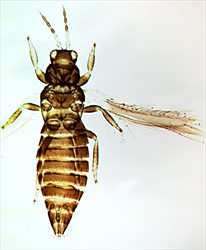
Female

Antenna

Antenna
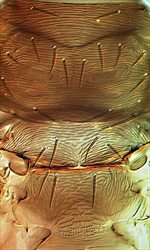
Macroptera - pro, meso & metanota
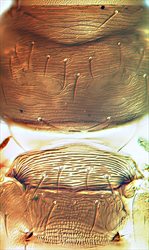
Microptera - pro, meso & metanota
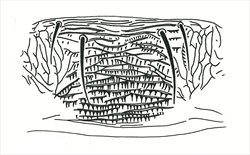
Metanotum
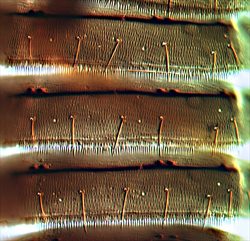
Tergites IV-VI

Tergites VII-IX
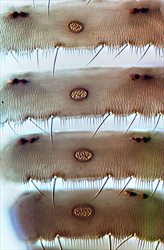
Male sternal pore plates
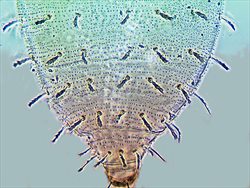
Larva II - tergites V-X
Female microptera. Body dark brown; tarsi yellow, tibiae variably brownish yellow; antennal segments I–III yellowish, IV–VIII brown. Antennae 8-segmented, segment III slender, sense cone forked and short, not extending beyond basal fifth of segment IV. Head weakly sculptured in ocellar triangle, striate posterior to occipital ridge; occipital apodeme not confluent with posterior margin of eyes; ocellar setae III on margins of ocellar triangle; maxillary palps 3-segmented. Pronotum with widely spaced, transversely anastomosing striae, with many small sculpture lines between the striae. Mesonotum with transverse striations, fine markings present between the striae. Metanotum transversely striate, with closely spaced microtrichia covering posterior two-thirds of the sclerite; median metanotal setae arising less than 0.3 times their length from the anterior margin. Metasternal plate with anterior margin straight. Tergites fully covered with densely spaced microtrichia, bearing three pairs of large discal setae; tergite IX with 3 pairs of mid-dorsal setae and no campaniform sensilla; sternites II–VI with lobed craspedum bearing microtrichia, absent medially on VII.
Female macroptera uncommon. Similar in colour to microptera, fore wing light brown with base sharply paler. Metanotum almost reticulate, with few microtrichia except close to posterior margin.
Male microptera similar to female but smaller; sternites IV–VII each with a small round pore plate; sternite VIII with postero-marginal setae S1 less than 70 microns long.
The monophyly of Thripidae subfamily Sericothripinae was recently confirmed by Lima & Mound (2016), and the current concept of three valid genera within the subfamily follows Wang (2007) and Mound & Tree (2009). The genus Sericothrips currently comprises eight species that occur mainly in the northern hemisphere, but only two species are known from Europe (zur Strassen, 2003). These two species are similar to each other in colour and structure, but are readily distinguished by the position of the median metanotal setae, the distribution pattern of microtrichia on the metanotum, and the number of mid-dorsal setae on tergite IX of females. Species of Sericothrips have the abdominal tergites fully covered with rows of microtrichia, in contrast to species of Hydatothrips and Neohydatothrips.
Feeding and breeding on leaves, and apparently host specific to Ulex species, particularly Ulex europaea [Fabaceae]. This thrips has been introduced into some countries as a biocontrol agent against gorse where this had become an invasive weed.
Found widely across Britain, from Kent and the Isles of Scilly to Caithness, and has also been recorded from County Cork in Ireland (Mound et al., 1976). This species is recorded in Spain, France, Denmark and Sweden, and more widely in eastern Europe south east to Bulgaria. It has been introduced to Hawaii, New Zealand, Tasmania and St Helena, as a biocontrol agent against its invasive host plant, Ulex europaeus.
THRIPIDAE - SERICOTHRIPINAE
Sericothrips staphylinus Haliday
Sericothrips staphylinus Haliday, 1836: 444
Lima EFB & Mound LA (2016) Systematic relationships of the Thripidae subfamily Sericothripinae (Insecta: Thysanoptera) Zoologischer Anzeiger 263: 24–32.
Mound LA, Morison GD, Pitkin BR & Palmer JM (1976) Thysanoptera. Handbooks for the Identification of British Insects 1 (11): 1–79.
Mound LA & Tree DJ (2009) Identification and host-plant associations of Australian Sericothripinae (Thysanoptera, Thripidae). Zootaxa 1983: 1–22.
Wang C-L (2007) Hydatothrips and Neohydatothrips (Thysanoptera, Thripidae) of East and South Asia with three new species from Taiwan. Zootaxa 1575: 47–68.
zur Strassen R (2003) Die terebranten Thysanopteren Europas und des Mittelmeer-Gebietes. Die Tierwelt Deutschlands 74: 1–271.